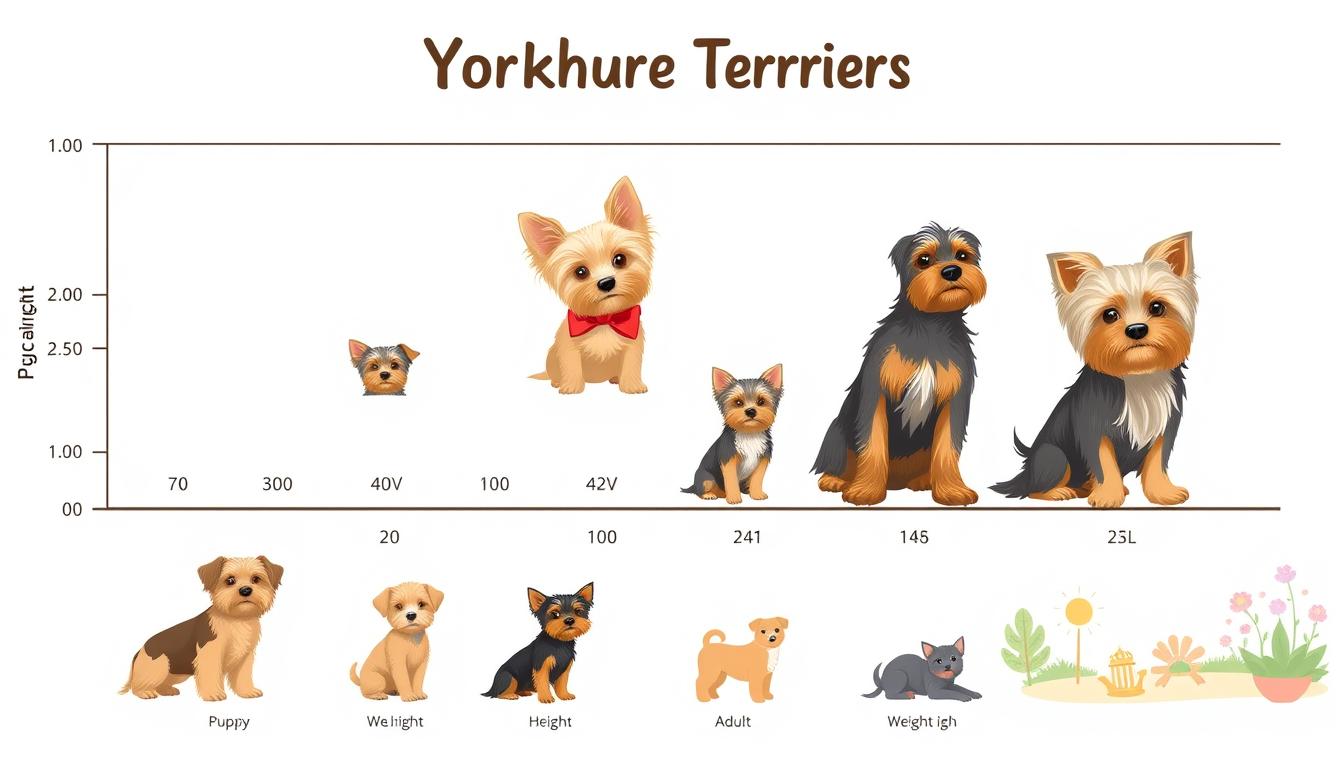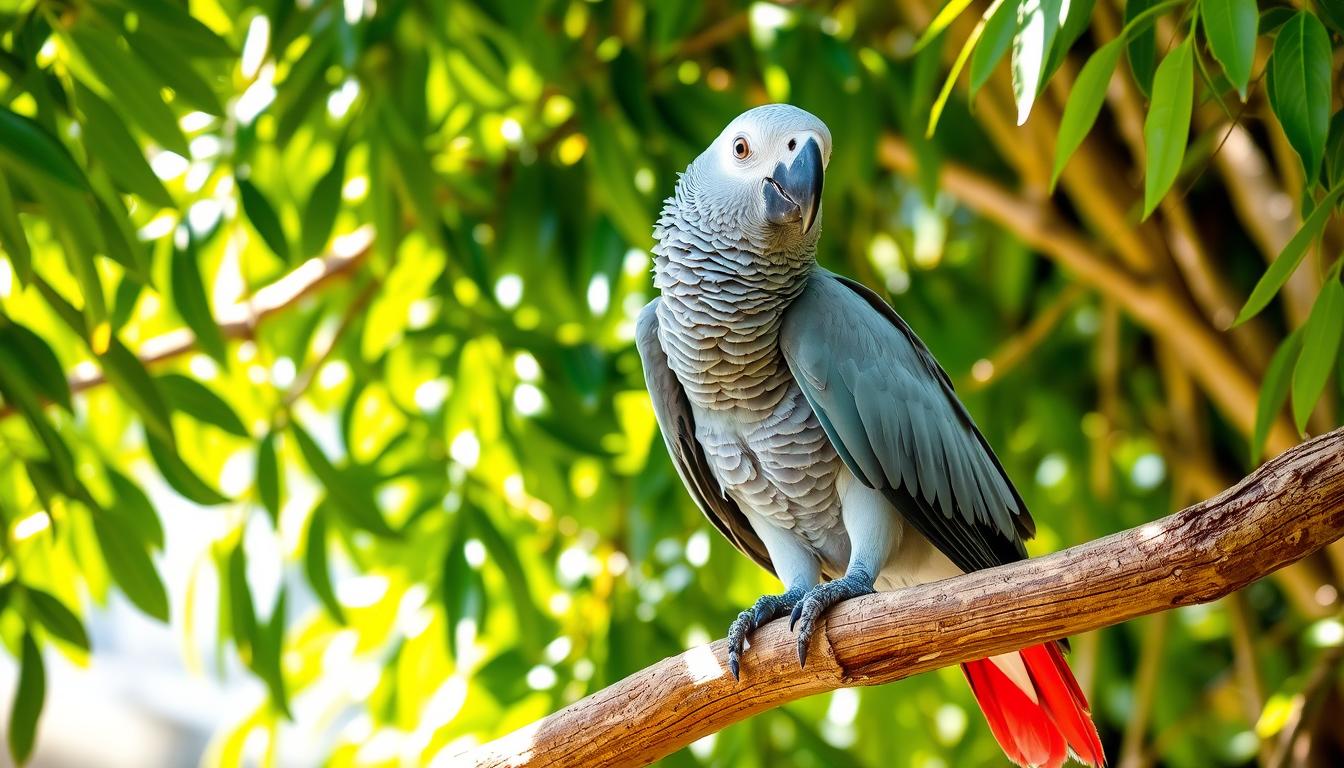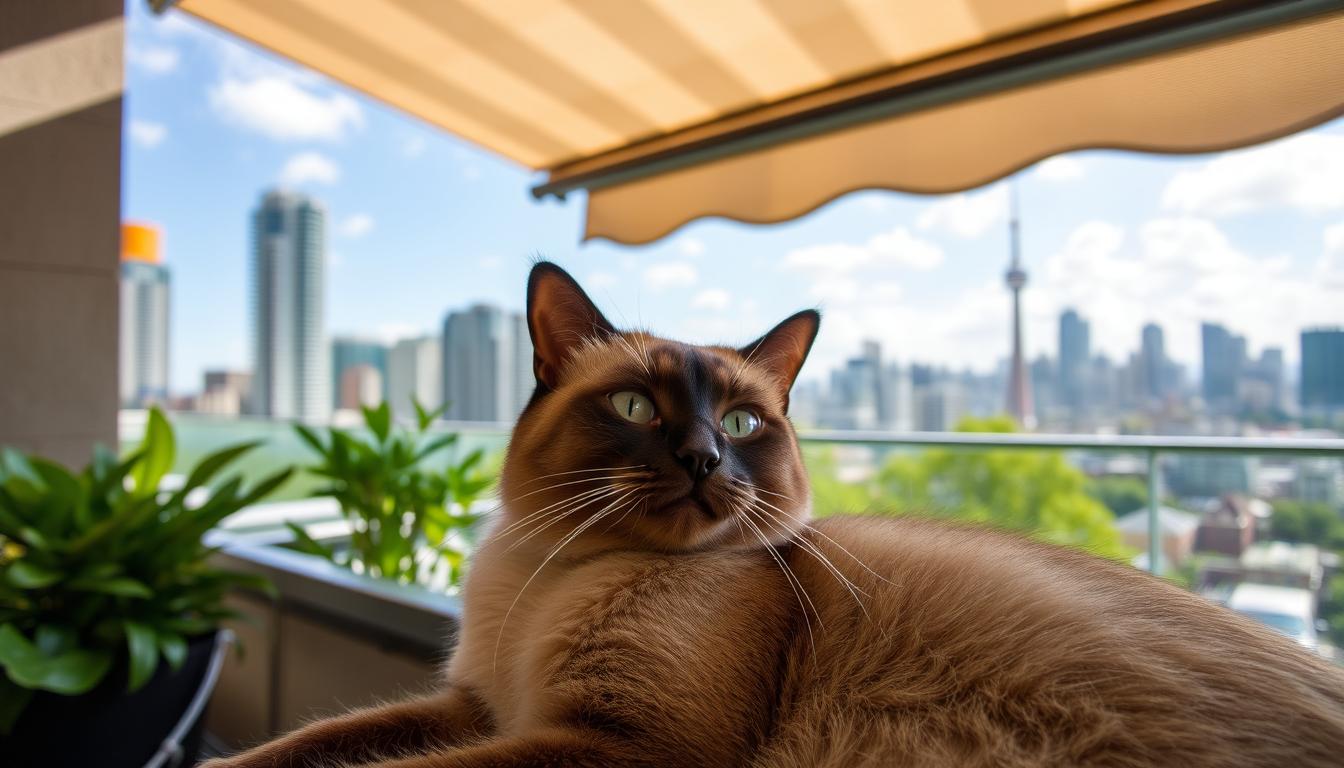Mexican Red Head Parrot: A Colorful Companion Bird
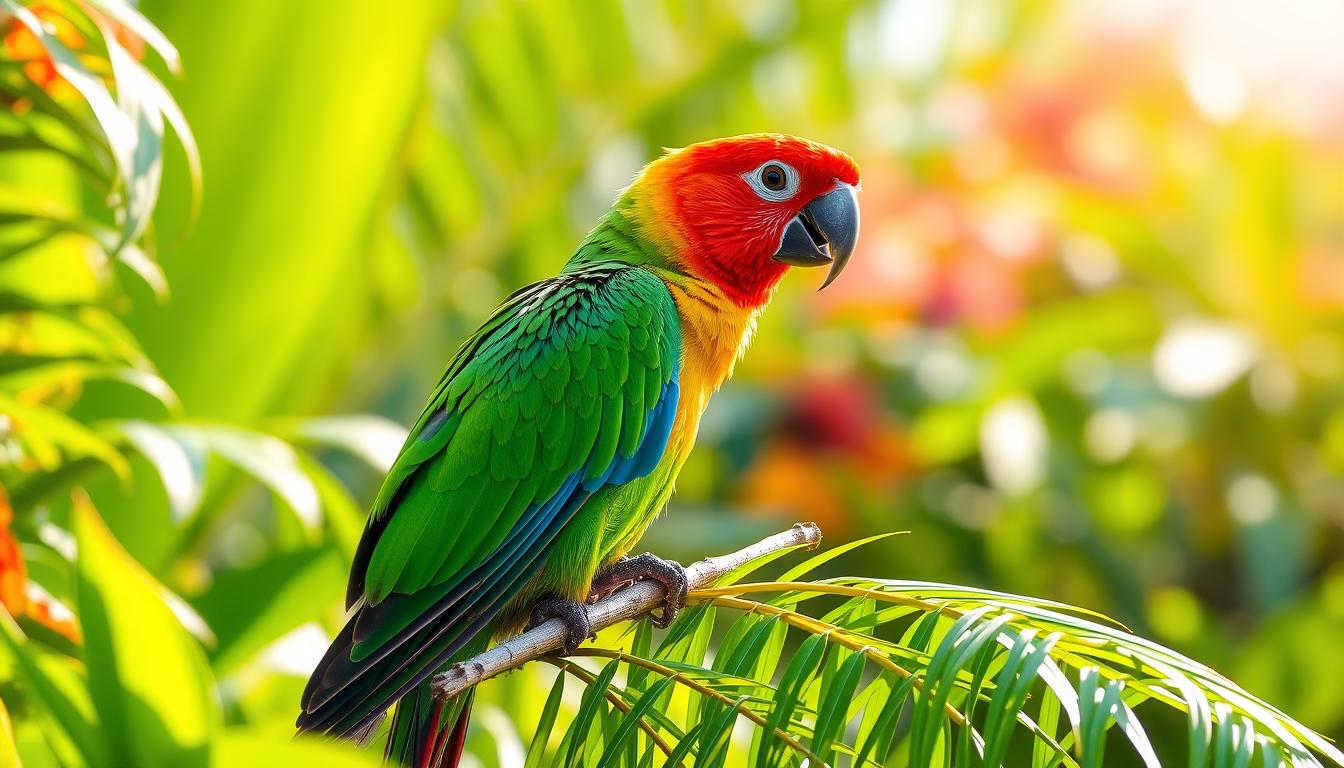
Did you know the Mexican Red Head Parrot can live over 50 years in captivity? This bird is loved for its stunning looks and lively personality. It has a bright red forehead and green feathers, making it a standout in the exotic bird world.
As a social bird, it needs lots of interaction. Knowing how to care for it is key to its happiness. Learning about this parrot can make your experience with it rewarding. For more info, check out the link to see how it’s protected beyond being a pet1.
Key Takeaways
- The Mexican Red Head Parrot can live over 50 years in captivity.
- These birds are known for their striking red foreheads and vibrant green feathers.
- Social interaction is crucial for the well-being of this parrot species.
- The Mexican Red Head Parrot thrives in a stimulating environment.
- Understanding their care needs is essential for a happy pet-owner relationship.
Overview of the Mexican Red Head Parrot
The Mexican Red Head Parrot, known as Amazona viridis, is a stunning exotic bird. It comes from northeastern Mexico and southern Texas. This parrot is about 11 to 13 inches long and weighs around 9.5 ounces2. Its bright colors and friendly nature make it a favorite among bird lovers.
Unfortunately, this parrot is endangered. It faces big threats from losing its home and being caught for pets. This has made its numbers go down3. It’s important to save this bird, as there are only 3,000 to 6,500 left in the wild3.
This amazing bird also does well in cities, like California. There, people work hard to keep an eye on and protect it3. It’s key to know how important they are and to protect their homes. This way, future generations can still see their beauty.
Physical Characteristics of the Mexican Red Head Parrot
The Mexican Red Head Parrot is a vibrant bird known for its striking looks and playful nature. Its size and weight make it a great companion bird. It measures 11 to 13 inches long and weighs 300 to 450 grams, showing a strong build that matches its lively personality4.
Coloration and Size
This parrot is famous for its bright red forehead and crown. Its dark blue eye streaks add to its vibrant look. As they grow, their eye colors change from bright yellow to deep red, while young ones have gray irises. Their yellow-tipped tails add elegance to their look.
Distinctive Features
The Mexican Red Head Parrot has unique facial features, like a white eye-ring that makes its eyes stand out. Its beak and ceres are horn-colored, sometimes with black accents. Its legs range from beige to gray, and its cheek feathers are golden and green. It’s important to note that telling the gender of this parrot often requires genetic testing4.
Natural Habitat and Range of the Mexican Red Head Parrot
The Mexican Red Head Parrot is known for its bright colors. It lives mainly in lowland forests in northeastern Mexico. These parrots also live in Southern Texas, showing they can adapt to different places.
They don’t usually move around much, but they might go further to find food. This can sometimes lead them to cities where they live in the wild.
In Mexico, they like areas with rivers and thorn forests. Places like Nuevo León, Tamaulipas, San Luis Potosí, and Veracruz are key for them. Here, they find food and make nests in forests with many plants5.
But, losing their homes is a big problem for them. In southern Texas, over 80% of their natural habitat is gone. This hurts their way of life5.
A 2023 survey by Texas Parks and Wildlife found fewer than 2,000 in the wild now6.
| Region | Key Characteristics | Population Status |
|---|---|---|
| Northeastern Mexico | Lowland forests, riparian corridors | Estimated population: 2,000–4,300 adults as of 1994 |
| Southern Texas | Urban adaptations, roosting in human communities | Estimated population: Around 900 birds currently |
| Feral Populations | Established in Oahu, Southern California, Florida, and Puerto Rico | Resulting from illegal release of domesticated birds |
As cities grow, Red-crowned Amazons meet other parrots more often. This could mix their genes and harm their special traits6. We need to keep them safe in their homes and beyond.
Behavior and Social Dynamics
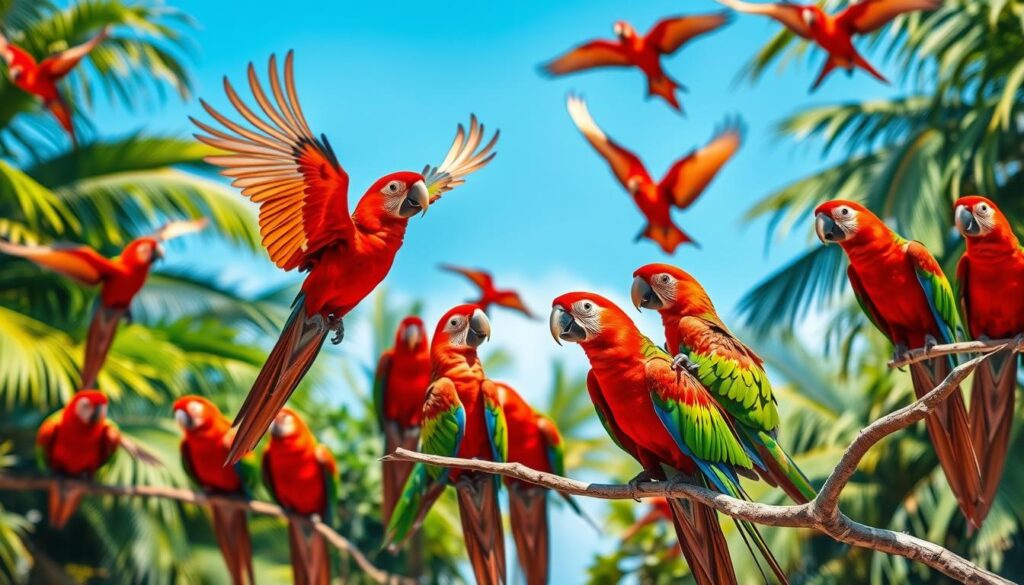
Mexican Red Head Parrots are fascinating to watch, showing how they live together. They love to be in groups, which makes them happy and healthy. Their flock behavior of mexican red head parrot shows they are social birds. They make noise and travel together, especially when looking for food.
Flock Behavior
These parrots enjoy being with others, often in big groups. Their nomadic life helps them adjust to changes in their environment. Watching them together gives us a peek into their social dynamics of parrots. Living together helps them find food and strengthens their friendships.
Communication Styles
Their communication styles of mexican red head parrot are interesting. They make unique sounds while moving in groups, which can warn others or signal to friends. They also show feelings through their eyes, making their interactions even more special.
Studying their behavior and communication can help both pet owners and scientists. You can learn more by checking out this article about evolution and behavior.
| Characteristics | Description |
|---|---|
| Flock Size | Forms large groups during feeding and migration. |
| Communication | Distinctive screeches and mimicry of environmental sounds. |
| Social Interaction | Strong bonding through communal activities. |
| Emotional Signals | Eye color changes indicating emotional states. |
Knowing these things can make your bond with these amazing birds stronger. It also helps in caring for them in captivity7.
Dietary Needs of the Mexican Red Head Parrot
The Mexican Red Head Parrot’s diet is key to its health and long life. Knowing what they eat in the wild helps us feed them right as pets. These parrots need a varied diet to stay healthy.
Wild Diet Composition
In the wild, these parrots eat seeds, fruits, flowers, and nectar. This mix gives them the nutrients they need for energy and bright colors. Seeds should not be the main part of their diet because they are too fatty and lack important vitamins.
This can lead to health issues like obesity and malnutrition. A balanced diet is crucial for their physical health.
Recommended Diet in Captivity
For a healthy life in captivity, their diet should be mostly pelleted food, about 60-70%8. The rest, 30-40%, should be fresh fruits and veggies, especially those with vitamin A like oranges and yellows8. It’s also important to give them clean, fresh water every day and wash their dishes daily8.
While they can have a little bit of human food, it should be healthy and not processed or salty. This helps avoid health problems.
It’s good to check their weight every week because they can get fat if they eat too many seeds9. Their diet needs change a lot, especially when they’re breeding10. So, it’s important to watch their diet closely and make changes as needed.
| Diet Component | Percentage of Daily Intake |
|---|---|
| Pelleted Diets | 60-70% |
| Fresh Fruits & Vegetables | 30-40% |
| Seeds | Minimal |
| Water | Always Available |
Following these dietary guidelines will help keep your pet bird healthy, active, and full of life8910.
Conservation Status and Threats
The Mexican Red Head Parrot, also known as the Red-crowned Amazon, is in big trouble. The endangered species status of Mexican red head parrot is confirmed by the IUCN. They say the species is endangered because its population has dropped by about 95 percent in recent years11.
The parrot’s natural home has shrunk a lot, losing 77% of its habitats in Mexico12. Now, there are only between 2,000 and 4,300 adult parrots left. Most of them live in the Lower Rio Grande Valley, which is very vulnerable11.
Endangered Species Status
The endangered species status of Mexican red head parrot shows we need to act fast to save it. Even though there are only about 4,700 birds in the U.S., they don’t get enough protection. Without federal protection, their survival is even harder because their homes are being destroyed12.
Main Threats to Survival
The threats to Mexican red head parrot survival are many and serious. Their homes are being destroyed fast, with over 80% of their natural habitat gone5. Also, many are caught for the pet trade, with thousands taken from the wild each year5. We must act quickly to save this parrot for the future.
Aviculture: Keeping a Mexican Red Head Parrot as a Pet
Keeping a Mexican Red Head Parrot as a pet is rewarding. It requires careful attention to their social needs and training. These parrots love to interact and need it early to adjust well.
Use positive reinforcement techniques in training. Teach them basic commands and get them used to different places. Learning various sounds boosts their confidence.
Socialization and Training
Socialization is key in training pet parrots. A well-socialized Mexican Red Head Parrot is calm and less likely to have behavior problems. Expose them to new places, people, and pets to make them versatile.
Set aside time each day for training. Be consistent and positive to build trust and confidence.
Common Behavior Challenges
Even though they are loving, Mexican Red Head Parrots may face behavior issues. These can include biting or loud noises when they feel scared. Give them lots of toys and interaction, and make sure they get enough exercise.
These steps help create a peaceful environment. It meets their emotional and social needs, making them happier.
Knowing what aviculture entails is crucial for a good bond with your parrot. For more information on care and training, check out guides online. Also, learn about the value of social interactions from resources about living with pet parrots here1314.
Mexican Red Head Parrot Care Tips
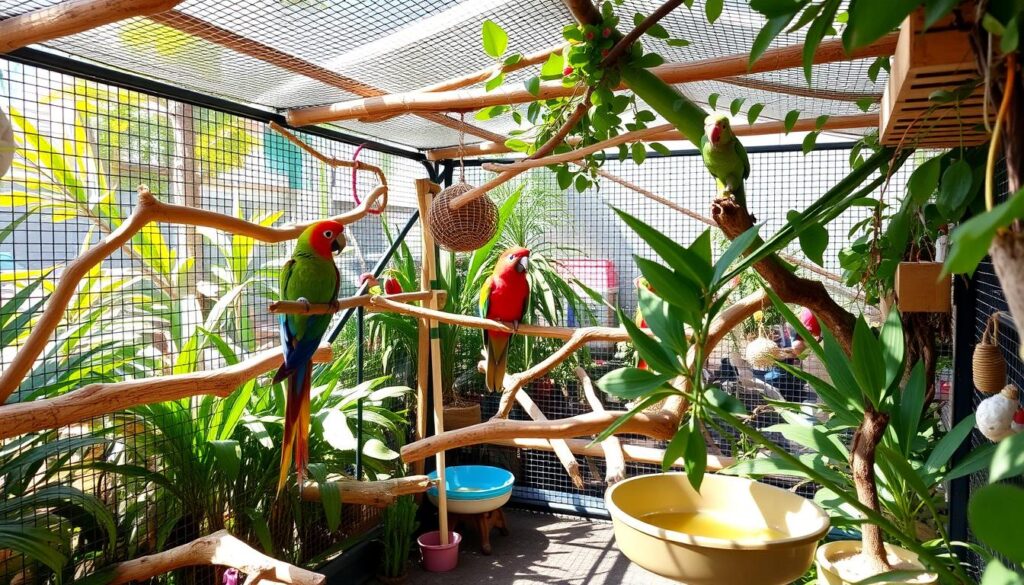
Taking care of a Mexican Red Head Parrot means paying attention to their housing and health needs. Knowing these details is key to making sure your parrot is happy and healthy at home.
Ideal Housing Requirements
Your parrot needs a lot of room to move and play. A cage that’s at least 36 inches long, 24 inches wide, and 66 inches high is best. This size lets your parrot move around comfortably.
It’s also important to make their space interesting. Add different perches, toys, and places to forage. A fun and varied environment keeps your parrot happy and active.
Health and Exercise Needs
Keeping your parrot active is crucial for their health. Spend time with your parrot outside of their cage every day. This helps prevent obesity and keeps their mind sharp. Aim for at least three hours of out-of-cage time daily.
Don’t forget to take your parrot to the vet regularly. These visits help catch health problems early. By following these tips, you can ensure your Mexican Red Head Parrot lives a long, joyful life.
Common Myths about the Mexican Red Head Parrot
The myths about mexican red head parrot often confuse people. Some think these birds can’t bond with humans or talk. But, with the right care, they can become very attached and even mimic sounds like other popular pets.
Many believe the mexican red head parrot is too wild to be a pet. But, with the right training and environment, they can be loving and fun to be around. They need regular interaction and mental challenges to show their affectionate side.
There’s also a myth about their diet. Some think they only eat seeds. But, they need a diet full of fruits, veggies, and special pellets to stay healthy.
Lastly, some think mexican red head parrots don’t live long in captivity. But, with the right care, they can live for decades.
| Myth | Fact |
|---|---|
| Cannot bond with humans | Can form strong attachments with proper care |
| Wild temperament | Adequate training leads to affectionate behavior |
| Limited dietary options | Require a varied diet including fruits and vegetables |
| Short lifespan in captivity | Can live for several decades with proper care |
It’s important to know the truth about mexican red head parrots. By clearing up these myths, we can better care for them. This leads to a stronger bond between owners and their parrots, making their lives together more fulfilling1516.
Conclusion
The Mexican Red Head Parrot is a vibrant and stunning bird that adds joy and beauty to your life. But, caring for them is more than just showing love. It means meeting their dietary, social, and habitat needs. They can grow up to 11 to 13 inches long and weigh about 270 grams, making them a big bird17.
With only about 4,700 in the U.S. and listed as endangered, their care is vital for their survival17.
To create a caring home, remember their love for company. They need interaction with people and other birds to stay happy17. Make sure they have fun activities to avoid boredom17.
Also, feed them a balanced diet of seeds, fruits, and special bird food17. Protecting their homes from poaching and habitat loss is key to their survival.
By being a responsible owner and caring for their habitat, you help ensure their beauty and spirit live on. This not only makes owning a bird rewarding but also helps save an endangered species18.
FAQ
What is the Mexican Red Head Parrot known for?
How big does a Mexican Red Head Parrot grow?
What does the Mexican Red Head Parrot eat?
Why is the Mexican Red Head Parrot endangered?
How can I socialize and train my Mexican Red Head Parrot?
What type of habitat does the Mexican Red Head Parrot prefer?
What are some common behavior challenges faced by Mexican Red Head Parrots?
What are the ideal housing requirements for a Mexican Red Head Parrot?
Can Mexican Red Head Parrots mimic speech?
What should I do for my Mexican Red Head Parrot’s health and exercise needs?
Source Links
- https://www.petguide.com/breeds/bird/mexican-red-headed-amazon/ – Mexican Red Headed Amazon Parrot Health, Personality, and Colors – PetGuide
- https://www.birdwatchingacademy.com/red-crowned-parrot/ – Red Crowned Parrot – Bird Watching Academy
- https://www.californiaparrotproject.org/red_crowned_parrot.html – The California Parrot Project
- https://susanclubb.com/knowledge-center/bird-species-profiles/14-amazons/31-mexican-red-headed-amazon – Susan Clubb – Mexican Red-Headed Amazon
- https://www.allaboutbirds.org/guide/Red-crowned_Amazon/lifehistory – Red-crowned Amazon Life History, All About Birds, Cornell Lab of Ornithology
- https://www.forbes.com/sites/grrlscientist/2023/09/25/an-endangered-mexican-parrot-is-thriving-in-urban-areas-of-south-texas/ – An Endangered Mexican Parrot Is Thriving In Urban Areas Of South Texas
- https://vetspace.2ndchance.info/the-red-crowned-parrots-of-brownsville-fight-for-their-citizenship/ – The Red-Crowned Parrots Of Brownsville Fight For Their Citizenship – Ron Hines’ Vetspace – 2nd Chance – The Animal Health Website
- https://vcahospitals.com/know-your-pet/amazon-parrots-feeding – Amazon Parrots – Feeding | VCA Animal Hospitals
- https://www.viparrot.com/mexican-red-headed-amazon/ – Mexican Red Headed Amazon 101: Everything You Need to Know About This Stunning Parrot | VIParrot
- https://www.petplace.com/article/birds/general/choosing-a-mexican-red-headed-amazon – Choosing a Mexican Red-Headed Amazon
- https://abcbirds.org/blog20/red-crowned-parrot/ – Parrot Paradox: The Unprotected, Endangered Red-crowned Parrot
- https://www.federalregister.gov/documents/2011/10/06/2011-25808/endangered-and-threatened-wildlife-and-plants-red-crowned-parrot – Endangered and Threatened Wildlife and Plants; Red-Crowned Parrot
- https://journals.tdl.org/watchbird/index.php/watchbird/article/view/895 – Breeding Amazons In Captivity | AFA Watchbird
- https://forums.avianavenue.com/index.php?threads/amazon-spotlight-of-the-month-red-lored-amazons.16604/ – Amazon Spotlight of the Month: Red Lored Amazons
- https://urbannature.blog/tag/birds-of-mexico/ – birds of mexico – The Urban Nature Enthusiast
- https://www.parrotfunzone.com/explore-parrots/parrots-in-culture – Parrots in Culture
- https://petpawza.com/mexican-red-head-parrot-colorful-feathered-friend/ – Mexican Red Head Parrot: Colorful Feathered Friend
- https://squawkipedia.com/red-crowned-parrot/ – Red-Crowned Parrot – Squawkipedia.com

